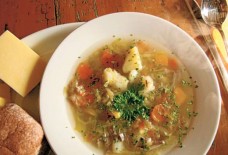The National Dish of Morocco: Couscous
By: Nouha Elyazidi / Arab America Contributing Writer
Imagine this: it is a sunny Friday, there happens to be a slight breeze brushing past as you are strolling down the cobblestone streets of Morocco. You are coming back from Jummah (Friday early-afternoon prayer) and as you are walking past the brightly colored architecture, there is a remarkable scent emerging from each and every home. The smell is encapsulating and you ask yourself, what is that aromatic blend of spices filling the air?
That would be Moroccan couscous. Couscous is the national dish of Morocco and is traditionally served every Friday following Jummah prayer. Couscous is prepared using the semolina wheat grain that is a staple in Moroccan kitchens. There are a variety of ways the dish can be prepared depending on the geographical region and preference of each family. The dish is prepared with steamed couscous grains, topped with a protein of choice, either chicken, beef, or lamb, and brought to life with a flavorful assortment of cooked and seasoned vegetables; carrots, onion, cabbage, gourd, potatoes, zucchini, squash, turnip, pumpkin, and sweet potatoes.
Couscous is prepared in a two-layer stainless steel pot/steamer called a keskas. The bottom of a keskas resembles a traditional pot, but the top piece has holes at the bottom and a dome-shaped lid. The vegetables and meat are cooked like a stew at the bottom of the pot, and the couscous grains are placed on top. This is done so the steam of the vegetable and meat can reach and add flavor to the couscous grains on top. As for the preparation of the meat and vegetables, the spices and key ingredients are ginger, turmeric, black pepper, salt, cured butter, olive oil, parsley, cilantro, and saffron.
Once the vegetables, meat, and couscous grains are prepared, the food is served on a large clay plate called a kasriya. It is served on a large plate because the dish is meant to be shared by everyone at the table.
The meat and vegetables are assorted in a way for maximum flavors in each bite. The steamed couscous grains are added to the kasriya. Once the grains are assembled into a cone shape, a large hole is made in the center to allow room for the meat. After, the vegetables are placed on top and around the meat. The last step in couscous assembly is typically a garnish, but the garnish differs depending on preference and the type of protein used. If the couscous is made with chicken the toppings might include almonds, boiled chicken or quail eggs, caramelized onions, and raisins. If lamb and beef are the protein of choice the toppings might be green chilis, red chili peppers, or chickpeas.
Now that the couscous is prepared we can dig in right? Well not quite yet, we need everything else that accompanies the dish. Usually matching the design of the kasriya, are small bowls with miniature ladles filled with a sauce called marka. Marka is the leftover broth from the vegetables and meat pot thoroughly seasoned and mixed with chickpeas with the purpose of keeping the couscous moist. It is served in smaller bowls so the couscous-consumers can adjust their level of sauce. As for a beverage, a tall cool glass of leben, or buttermilk, is the drink of choice for most Moroccans.
Now, my friends, it is time to dig into a unique flavorful dish you are guaranteed to love. But there is one final step to eating couscous we must address; the way the dish is eaten! Most people use spoons to scoop the couscous, but couscous professionals have another way. Much of Moroccan cuisine is eaten by hand, and this dish is no exception. Many will use the marka to soften the grain and scoop a small portion into their right hand with their desired amount of meat and vegetables. Then, they cup their hand and move the couscous around in a circular motion until it has formed into a little couscous ball. Many enjoy and prefer to eat the dish this way!
If you are interested in making couscous yourself, the blog Mindful Muslim has a detailed recipe with step-by-step instructions, to access it click here! No matter how it is prepared or eaten, couscous is a tremendous part of Moroccan culture. This dish has a long history in North Africa, it is believed to have been around for over 2,200 years! In a cultural sense, this dish is the pride and joy of Morocco. Not only that, but it is something that brings Moroccan families together. Couscous is a unique dish that is definitely worth trying!
Check out Arab America’s blog here!









